INBOX INSIGHTS: ChatGPT Survey Analysis, Root Cause Analysis (11/1) :: View in browser

Using ChatGPT for Survey Analysis
Last week we ran our quarterly 1 question survey. We asked, “If you had money left over in your marketing budget this year, what would you spend it on?”
You can still respond to our 1 question survey here.
We’re seeing budgets cuts across the board. So, our goal was to understand what’s is on the wish list so that we could see how to address it through content and other resources.
Because it’s a simple form, I can export the data into a CSV file. And then it occurred to me. Why should I struggle through analyzing this data when I can ask my pal, KatieGPT to do it for me?!
Ok, we haven’t yet built KatieGPT, so I’ll use ChatGPT instead.
For this exercise, I used GPT4 which allows you to upload data sets for analysis. And like every interaction with ChatGPT, you need a prompt. Mine was super basic:
“You are a market research analyst and you asked your audience”If you had money left over in your marketing budget this year, what would you spend it on?” You are analyzing the data to be easily understood.
Attached are the responses.
This is what you need to answer:
What are the overall themes?
Can you put these responses into some kind of chart?
What was surprising?
What will people primarily spend their budgets on?
Show your work
Provide a download links for any images or charts”
When I saw Andy Crestodina present his session on using GA4 data for SEO a few weeks ago, he did so using ChatGPT. It was really straightforward but incredibly powerful. One of the pro-tips that stood out to me was to ask ChatGPT, “provide a download link”. So simple. So genius. Thanks, Andy!
Here is what ChatGPT told me was in the data:
- Overall Themes:
- Research and analytics tools
- Data and design improvements
- Marketing and website enhancements
- AI and training
- Marketing strategy and tools
- Primary Areas for Spending:
- People are primarily interested in spending their leftover marketing budgets on AI and training, followed by marketing strategy and tools.
- Surprising Insights:
- A significant focus on AI and training indicates that marketers are keen on leveraging AI to enhance their marketing efforts and are willing to invest in training to better understand and utilize AI tools.
It’s interesting that ChatGPT thinks AI education is a suprising insight. I don’t find that surprising at all.
And when we drill down into the themes themselves:
- Research and Analytics
- Keywords: research, tool, analytics, help, consultant, clients, user, track, streamline, engagement
- Data and Design
- Keywords: data, figuring, design, bad, cleansing, added, prevent, processes, leverage, thrive
- Marketing and Website
- Keywords: money, ai, marketing, new, website, meetup.com, asking, left, cms, content
- AI and Training
- Keywords: ai, training, marketing, video, budget, order, insights, education, id, tools
- Marketing Strategy and Tools
- Keywords: marketing, tools, ability, great, strategy, new, use, years, year, unified
Ok, this is interesting. I’m starting to see the specific language used within each theme. This is pretty valuable to any marketer.
Because I was curious to see it visualized, I also asked for a a chart and a word cloud. Here’s the word cloud, but I don’t find it to be super helpful:

All told, this took me 30 minutes. Less time that it’s taking me to write it up. The next question is the best question. So what? What do we do with this information? I know what my answer is, but since we’re on a roll, I asked ChatGPT.
This is where the wheels started to come off.
The suggestions from ChatGPT were fairly generic and uninspired. Many of the suggestions were theoretical and not tactical.
But we were doing so good!
Alright ChatGPT, you’re off the hook for now. Let’s go back to the specific keywords. That starts to fill in our content calendar, our targeting, our topics. We want to mirror the language used by our audience so it resonates with them when they see it.
All told, I think ChatGPT did a pretty good analysis. It’s basic, sure. But it got me what I needed. I have some actionable data that I can start using, all in the same amount of time it takes to get a pizza delivered. Be on the lookout for more content using your feedback!
How are you using AI to understand your audience? Reply to this email to tell me or come join the conversation in our Free Slack Group, Analytics for Marketers.
– Katie Robbert, CEO
November 2023 One Click Poll
Please click/tap on just one answer – this is our monthly survey to see how we’re doing, so please do take it each month!
How likely are you to recommend Trust Insights as a consulting firm to someone in the next 90 days?
We use this information to measure how effective our marketing is. There’s no form to fill out – tapping your answer is literally all there is to it. Thank you for your help!

Do you have a colleague or friend who needs this newsletter? Send them this link to help them get their own copy:
https://www.trustinsights.ai/newsletter

In this episode of In-Ear Insights, the Trust Insights podcast, Katie and Chris discuss how to better manage people and marketing through frameworks and anticipation. We talk about how anticipating questions, needs, and potential issues can help smooth communications between managers and employees. Chris shares how predictive analytics and AI assistants can help managers plan for situations and employee interactions. Katie suggests using frameworks to set context and clarify purpose when starting potentially tough conversations. We explore emotional barriers to anticipation and how to create psychological safety. Tune in to learn communication tips for improving management and marketing outcomes through anticipating needs.
Watch/listen to this episode of In-Ear Insights here »
Last time on So What? The Marketing Analytics and Insights Livestream, we reviewed the CMO Survey’s latest results. Catch the episode replay here!
This week on So What? The Marketing Analytics and Insights Live show, we’ll be talking about predictive analytics and marketing planning. Tune in Thursday at 1 PM Eastern Time! Are you following our YouTube channel? If not, click/tap here to follow us!

Here’s some of our content from recent days that you might have missed. If you read something and enjoy it, please share it with a friend or colleague!
- How Generative AI can help with Monthly Reporting
- So What? Review of the September 2023 CMO Survey
- Marketing Event Attendee Success Guide
- In-Ear Insights: CMO Survey, AI, and 2024 Marketing Budgets
- INBOX INSIGHTS, October 25, 2023: Data Governance, Hot Ones Text Analysis
- Understanding Customer Needs with a Purpose and Data
- Almost Timely News, October 29, 2023: Key Roles in Your Generative AI Pilot Team

Take your skills to the next level with our premium courses.

Get skilled up with an assortment of our free, on-demand classes.
- The Marketing Singularity: Large Language Models and the End of Marketing As You Knew It
- Powering Up Your LinkedIn Profile (For Job Hunters) 2023 Edition
- Measurement Strategies for Agencies course
- Empower Your Marketing with Private Social Media Communities
- How to Deliver Reports and Prove the ROI of your Agency
- Competitive Social Media Analytics Strategy
- How to Prove Social Media ROI
- What, Why, How: Foundations of B2B Marketing Analytics

Today, let’s tackle a question we’re all faced with at one point or another in your careers as a data analyst or data scientist:
Why are the numbers down? (or some variation thereof)
Answering this question can be one of the most challenging tasks you’ll face, partly because the question is an important one, but also because it’s usually accompanied by an outsized sense of urgency. The boss comes storming into the office/your desk/Zoom and demands to know why the numbers are down, or the client asks that very pointed question on the call.
How should you answer that question? To the topic of anticipation that Katie and I talked about this week on the podcast, how do you plan to answer that question, knowing it’s coming?
Unsurprisingly, the answer looks like every other answer in data analysis and data science: understand the problem, gather the data, analyze it, figure out what correlates to the outcome in question, and then develop a testing plan if you don’t have a clear answer. So let’s step through this process.
We’ll start with a barely fictional scenario: hey, our website traffic is down! Why?
On its face, this problem could have dozens, if not hundreds of answers. The first step is to understand the problem. The question we start with is, down compared to what? Last week? Last month? How are we down? If we start with the default view of our Google Analytics 4 data, it’s not terribly helpful:
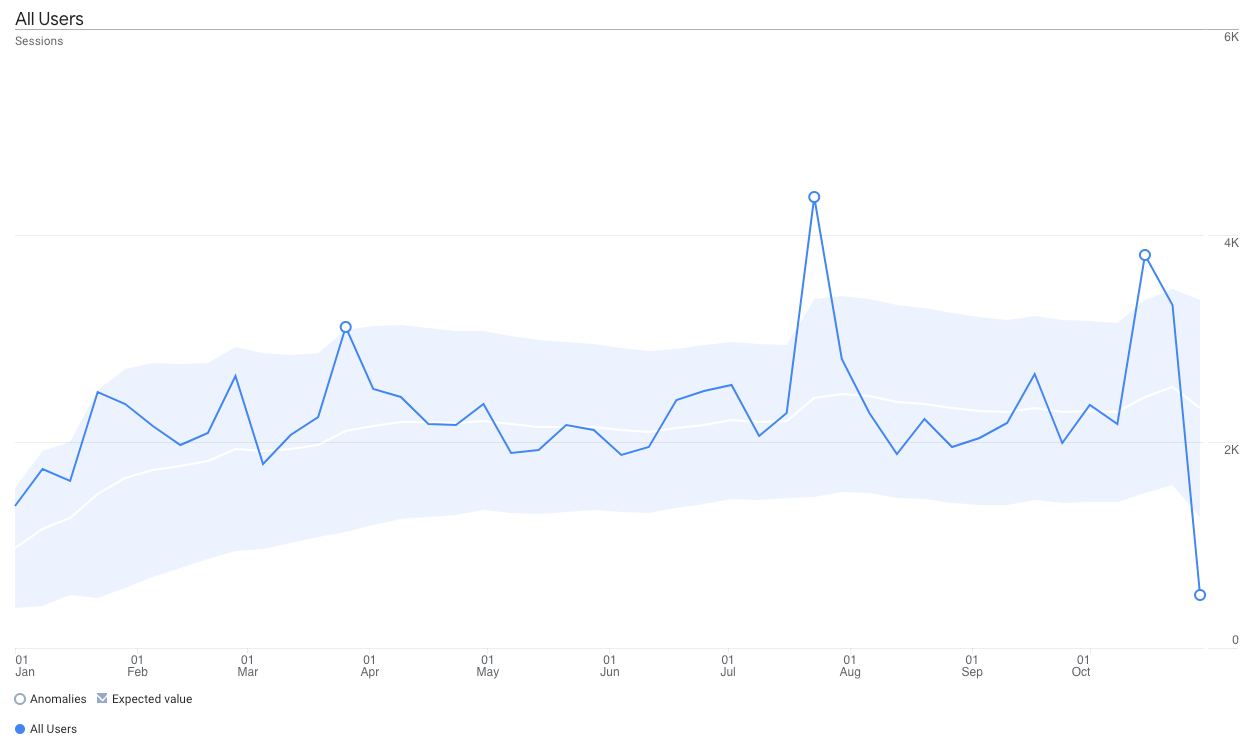
It’s not even apparent that traffic IS down, but let’s say for argument’s sake that it is. Website traffic is an aggregated number made up of lots of subcomponents, like marketing channels. So our first step would be to break apart our aggregated number into pieces:
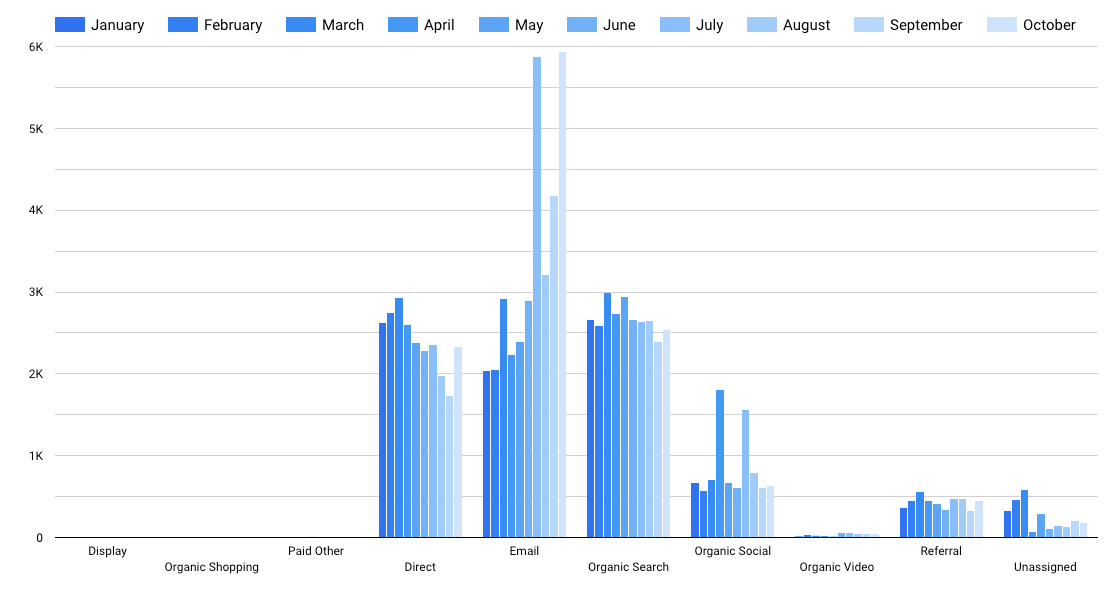
We had to switch to Looker Studio because Google Analytics 4 can’t do this kind of clustering and grouping. What we see is pretty apparent: direct traffic and organic search traffic are on the decline. Social and referral traffic are more or less steady. Email traffic has gone nuts the entire year.
By breaking up our big number into components, we now have a place to start investigating. We can’t do much about direct traffic, but we can look at things like organic search traffic. Now, search traffic mainly comes from Google, and even there, we have another big number we can break into components. Specifically, we can break search traffic into two pieces: impressions and clicks.

When we examine the data, we see that impressions and clicks are more or less correlated, but there are plenty of spots in the last year where clicks fall below impressions. This shearing means that our site is showing up in search results, but our audience doesn’t think what’s being shown is a good fit for their intent. As a result, we don’t earn the click.
What’s our next step? We’ve understood the problem. We’ve gathered the data. We’ve isolated what the problem is. Now we need to come up with a plan to fix the problem. Let’s look at our Search Console data in greater detail. What are the pages that are getting lots of impressions (and which terms) but not getting the clicks?
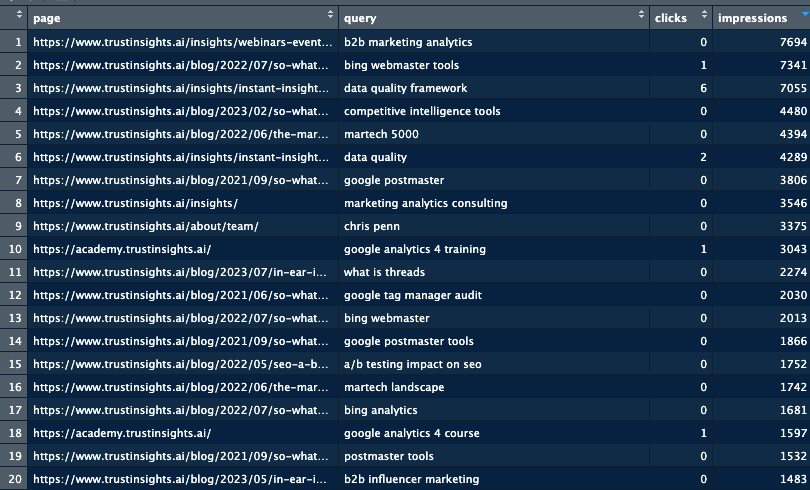
That’s quite a lot. That first page is one of our webinars, and let’s be honest… this page is kind of thin. Real thin.
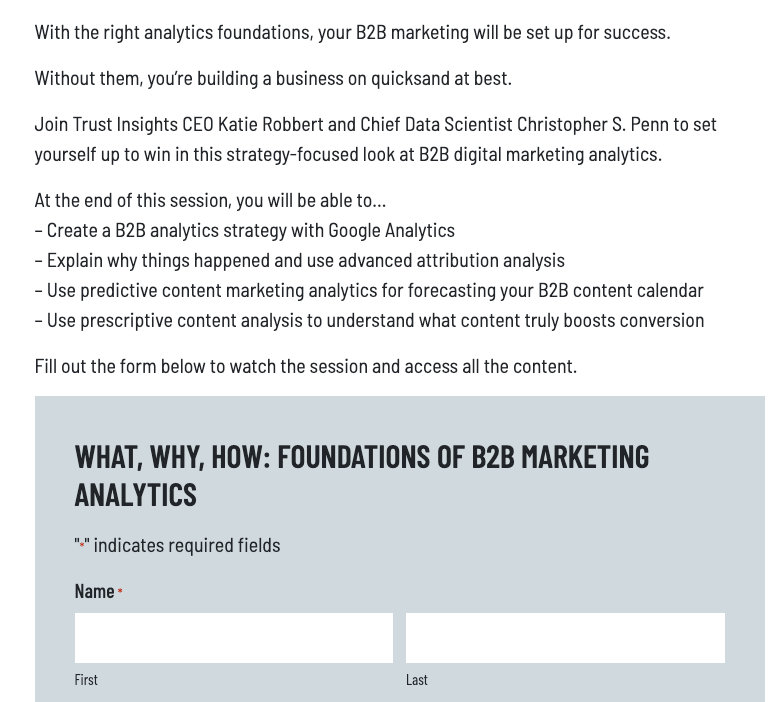
We know that Google’s recent algorithm changes have focused heavily on helpful content and this… well, it isn’t. At the very least, it’s not very telling for what you’re going to get. So how would we test out whether or not this is the problem? We’d make some revisions to the page and then measure its performance over time to see if it gets ANY clicks at all once we’ve revised it. It’s so far gotten 0 clicks this year, so literally anything would be an improvement.
This is a webinar, so we have lots of potential content for the page to make it more useful. We can put a featured image on it so people know what they’re getting. We can fix up the meta description so it’s more clear. We can take a transcript of the session and use generative AI to write a detailed outline. Let’s take all these steps and implement them.
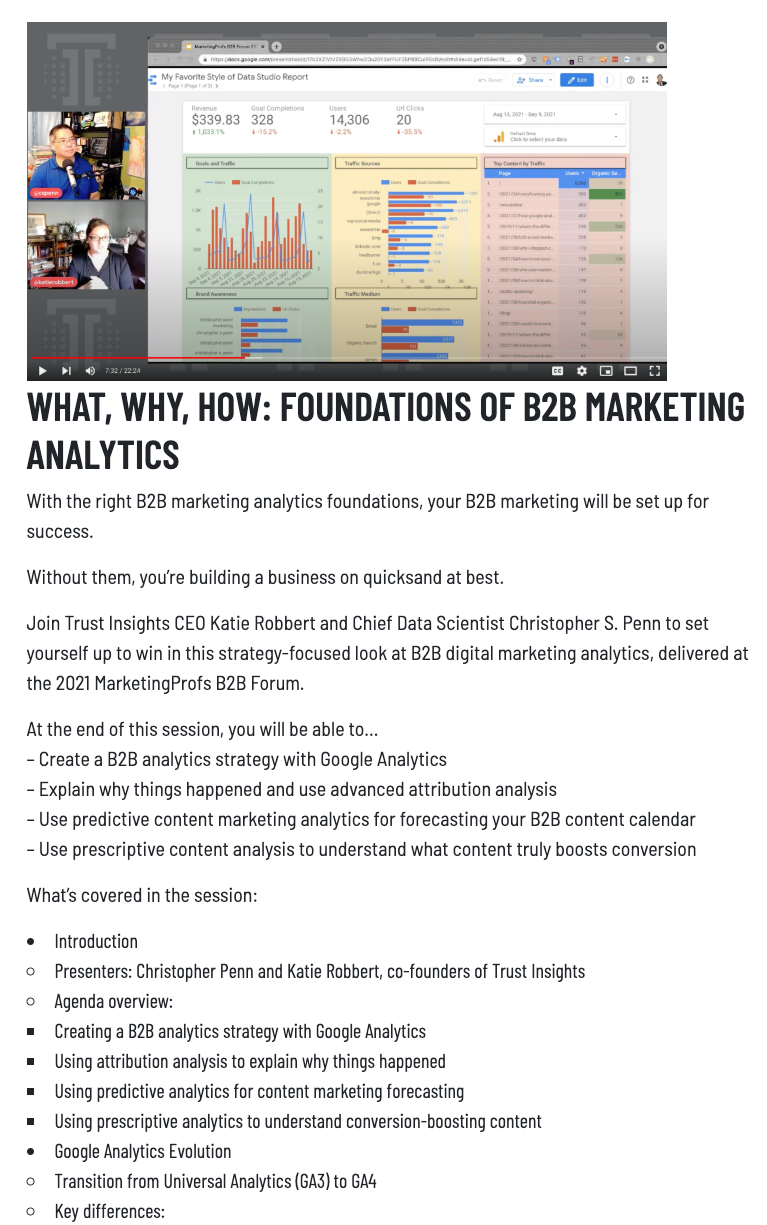
This is the last stage of the process, where you test out changes and track what happens. This is a case where it’s pretty clear anything would be an improvement over what was there – but had we not dug deep into why our overall website traffic was down, we might not have uncovered this and fixed it up.
When your stakeholders appear at your doorstep asking why a number is down, bring out this process. Understand, gather, analyze, and test. It’s the same process we use for our clients to help them fix their numbers when they’re going the wrong way.

- Case Study: Exploratory Data Analysis and Natural Language Processing
- Case Study: Google Analytics Audit and Attribution
- Case Study: Natural Language Processing
- Case Study: SEO Audit and Competitive Strategy

Here’s a roundup of who’s hiring, based on positions shared in the Analytics for Marketers Slack group and other communities.
- Ai Data Scientist at Coda Search│Staffing
- Analytics Lead at Curate Insights
- Director Data Science at Planet Technology
- Director, Performance Media at NextAfter
- Executive Communications Manager, North America at Lychee shadow
- Head Of Analytics & Data Science at Intrepid Digital
- Head Of Growth at RankPay
- Lead Customer & Agent Experience Data Analyst at Grange Insurance Careers
- Search Engine Optimization Manager at King Edward First
- Senior Growth Marketer at SumerSports
- Senior Vice President, Gaming at National Research Group
- Sr. Analyst, Crm Analytics at Shutterfly
- Sr. Analyst, Growth Analytics at Shutterfly
- Staff Ml Scientist (Growth & Optimization) at Coursera
- Vocabulary Community Manager at JPMC Candidate Experience

Are you a member of our free Slack group, Analytics for Marketers? Join 3000+ like-minded marketers who care about data and measuring their success. Membership is free – join today. Members also receive sneak peeks of upcoming data, credible third-party studies we find and like, and much more. Join today!

Now that you’ve had time to start using Google Analytics 4, chances are you’ve discovered it’s not quite as easy or convenient as the old version. Want to get skilled up on GA4? Need some help with your shiny new system? We can help in two ways:

Where can you find Trust Insights face-to-face?
- DigitalNow, Denver, November 2023
- Social Media Marketing World, San Diego, February 2024
- MAICON, Cleveland, September 2024
Going to a conference we should know about? Reach out!
Want some private training at your company? Ask us!

First and most obvious – if you want to talk to us about something specific, especially something we can help with, hit up our contact form.
Where do you spend your time online? Chances are, we’re there too, and would enjoy sharing with you. Here’s where we are – see you there?
- Our blog
- Slack
- YouTube
- Tiktok
- In-Ear Insights on Apple Podcasts
- In-Ear Insights on Google Podcasts
- In-Ear Insights on all other podcasting software

Our Featured Partners are companies we work with and promote because we love their stuff. If you’ve ever wondered how we do what we do behind the scenes, chances are we use the tools and skills of one of our partners to do it.
- StackAdapt Display Advertising
- Agorapulse Social Media Publishing
- WP Engine WordPress Hosting
- Talkwalker Media Monitoring
- Marketmuse Professional SEO software
- Gravity Forms WordPress Website Forms
- Otter AI transcription
- Semrush Search Engine Marketing
- Our recommended media production gear on Amazon
Read our disclosures statement for more details, but we’re also compensated by our partners if you buy something through us.

Some events and partners have purchased sponsorships in this newsletter and as a result, Trust Insights receives financial compensation for promoting them. Read our full disclosures statement on our website.

Thanks for subscribing and supporting us. Let us know if you want to see something different or have any feedback for us!










2 thoughts on “INBOX INSIGHTS, November 1, 2023: ChatGPT Survey Analysis, Root Cause Analysis”